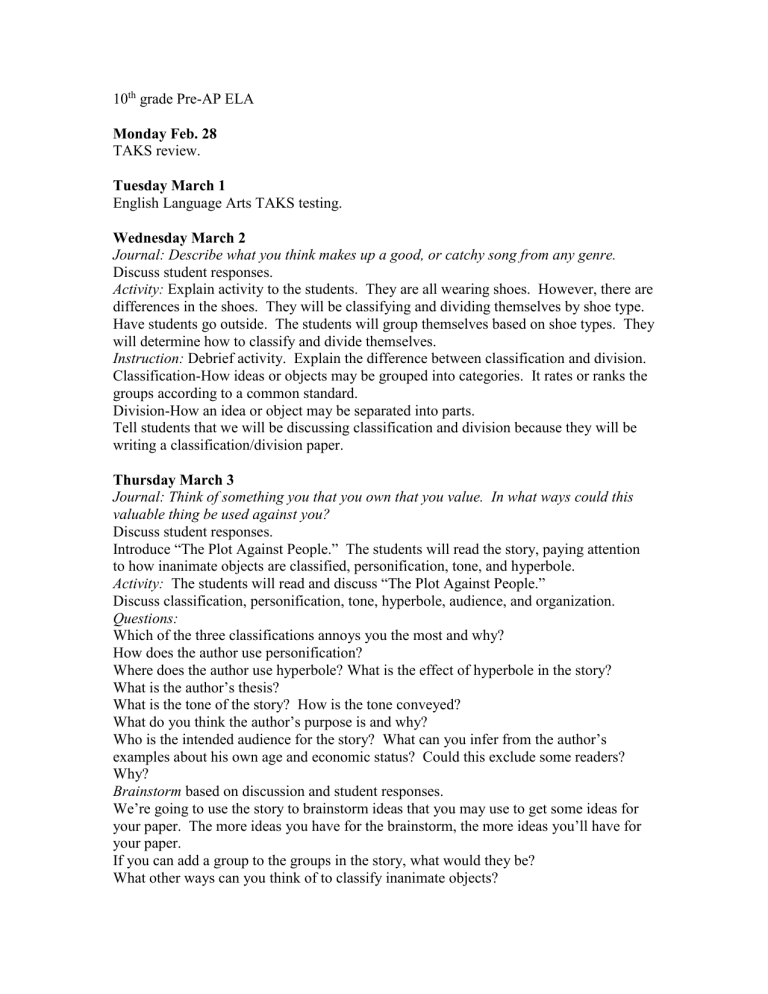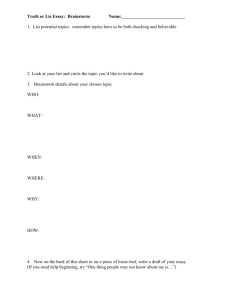Martinelli LP4

10 th
grade Pre-AP ELA
Monday Feb. 28
TAKS review.
Tuesday March 1
English Language Arts TAKS testing.
Wednesday March 2
Journal: Describe what you think makes up a good, or catchy song from any genre.
Discuss student responses.
Activity: Explain activity to the students. They are all wearing shoes. However, there are differences in the shoes. They will be classifying and dividing themselves by shoe type.
Have students go outside. The students will group themselves based on shoe types. They will determine how to classify and divide themselves.
Instruction: Debrief activity. Explain the difference between classification and division.
Classification-How ideas or objects may be grouped into categories. It rates or ranks the groups according to a common standard.
Division-How an idea or object may be separated into parts.
Tell students that we will be discussing classification and division because they will be writing a classification/division paper.
Thursday March 3
Journal: Think of something you that you own that you value. In what ways could this valuable thing be used against you?
Discuss student responses.
Introduce “The Plot Against People.” The students will read the story, paying attention to how inanimate objects are classified, personification, tone, and hyperbole.
Activity: The students will read and discuss “The Plot Against People.”
Discuss classification, personification, tone, hyperbole, audience, and organization.
Questions:
Which of the three classifications annoys you the most and why?
How does the author use personification?
Where does the author use hyperbole? What is the effect of hyperbole in the story?
What is the author’s thesis?
What is the tone of the story? How is the tone conveyed?
What do you think the author’s purpose is and why?
Who is the intended audience for the story? What can you infer from the author’s examples about his own age and economic status? Could this exclude some readers?
Why?
Brainstorm based on discussion and student responses.
We’re going to use the story to brainstorm ideas that you may use to get some ideas for your paper. The more ideas you have for the brainstorm, the more ideas you’ll have for your paper.
If you can add a group to the groups in the story, what would they be?
What other ways can you think of to classify inanimate objects?
List student responses on board. Have the students take notes.
Friday March 4
Journal: Does lying always harm people, or can it be beneficial? Think of a lie that you told, and the consequences of that lie. Was it harmful, or was it helpful?
Discuss student responses.
Introduce “The Ways We Lie.” The students will read the story, paying attention to how lies are classified, how they are defined and explained, the purpose of the story, and the tone.
Activity:
The students will read and discuss “The Ways We Lie.”
Discuss the classification, the purpose of the story, how effectively or ineffectively the lies were defined and explained, the tone of the piece.
Questions:
Do you think the epigraphs (short quotes) describe the corresponding lies well? Why or why not? Which of these epigraphs work best?
Look at the way the author uses definition and example to support her classifications.
Which definitions are the clearest? Which examples are the most effective? Why?
What is the author’s thesis?
What is the author’s purpose? What evidence is there?
Who is the intended audience for this essay? What evidence is there?
What is the tone of the essay? Are there certain lies in which the tone changes?
In paragraph 35, Ericsson writes, “Our acceptance of lies becomes a cultural cancer that eventually shrouds and reorders reality until moral garbage becomes as invisible to us as water is to a fish.” How do the two figures of speech in this sentence – cancer and garbage –relate to each other?
Does the author think it is possible to eliminate lies from our lives? What evidence does she offer?
Brainstorm based on discussion and student responses.
Remember, we’re going to brainstorm ideas based on the story so you may have more ideas for your paper.
Can you think of any categories that could be added to the ways we lie?
What other classifications can be made by using “The Ways we _____________?”
For example, the ways we talk. We talk quickly, slowly, with an accent, loudly, softly, whispering, yelling, hurriedly, hushed, etc.
List the ways we ________ on the board as the students give their answers. Have the students take notes.





